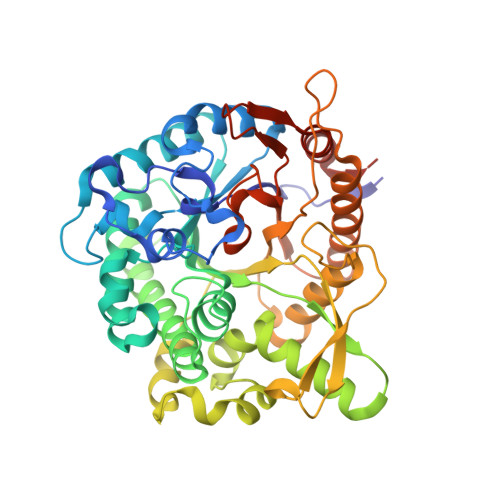Crystal structure of beta-glucosidase 1A from Thermotoga neapolitana and comparison of active site mutants for hydrolysis of flavonoid glucosides.
Kulkarni, T.S., Khan, S., Villagomez, R., Mahmood, T., Lindahl, S., Logan, D.T., Linares-Pasten, J.A., Nordberg Karlsson, E.(2017) Proteins 85: 872-884
- PubMed: 28142197
- DOI: https://doi.org/10.1002/prot.25256
- Primary Citation of Related Structures:
5IDI - PubMed Abstract:
The β-glucosidase TnBgl1A catalyses hydrolysis of O-linked terminal β-glycosidic bonds at the nonreducing end of glycosides/oligosaccharides. Enzymes with this specificity have potential in lignocellulose conversion (degrading cellobiose to glucose) and conversion of bioactive flavonoids (modification of glycosylation results in modulation of bioavailability). Previous work has shown TnBgl1A to hydrolyse 3, 4' and 7 glucosylation in flavonoids, and although conversion of 3-glucosylated substrate to aglycone was low, it was improved by mutagenesis of residue N220. To further explore structure-function relationships, the crystal structure of the nucleophile mutant TnBgl1A-E349G was determined at 1.9 Å resolution, and docking studies of flavonoid substrates were made to reveal substrate interacting residues. A series of single amino acid changes were introduced in the aglycone binding region [N220(S/F), N221(S/F), F224(I), F310(L/E), and W322(A)] of the wild type. Activity screening was made on eight glucosylated flavonoids, and kinetic parameters were monitored for the flavonoid quercetin-3-glucoside (Q3), as well as for the model substrate para-nitrophenyl-β-d-glucopyranoside (pNPGlc). Substitution by Ser at N220 or N221 increased the catalytic efficiency on both pNPGlc and Q3. Residue W322 was proven important for substrate accomodation, as mutagenesis to W322A resulted in a large reduction of hydrolytic activity on 3-glucosylated flavonoids. Flavonoid glucoside hydrolysis was unaffected by mutations at positions 224 and 310. The mutations did not significantly affect thermal stability, and the variants kept an apparent unfolding temperature of 101°C. This work pinpoints positions in the aglycone region of TnBgl1A of importance for specificity on flavonoid-3-glucosides, improving the molecular understanding of activity in GH1 enzymes. Proteins 2017; 85:872-884. © 2016 Wiley Periodicals, Inc.
- Biotechnology, Department of Chemistry, Lund University, Lund, SE-221 00, Sweden.
Organizational Affiliation:

















